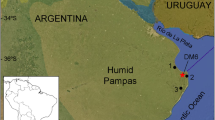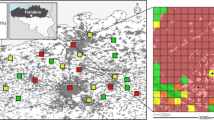Abstract
This article provides a meta-analysis of quantitative data available in literature regarding the relation between termite numbers and the volume of their mounds for 24 species belonging to 13 genera. The leading question behind this analysis is: “how do the respiratory gas exchanges regulate the size of termite mounds?” This question is answered through the analysis of the log–log regression between the volume of the mound and the number of inhabitants. The most confident data support the hypothesis of a respiratory regulation that can be achieved through a relation between the termite numbers and (1) the volume of their mounds (slope of the regression near 1, Noditermes), (2) the surface of the outer walls of their mounds (slope of the regression near 0.67, Termitinae and Nasutitermes) or (3) a compromise between the surface of the outer walls of their mounds and some linear structures of their nests (slope of the regression between 0.67 and 0.33, Trinervitermes and Macrotermes). The way this is achieved is linked with the architecture of the mound. A confident relation was found between the number of individuals and the epigeal volume of their mounds for 18 species for which the most reliable data were provided. Three more accurate models are proposed for estimating the termite population based on the nest material and architecture and on the size of the termites.








Similar content being viewed by others
References
Bouillon A. and Lekie R. 1964. Populations, rythme d’activité diurne et cycle de croissance du nid de Cubitermes sankurensis Wasmann (Isoptera, Termitinae). In: Études sur les Termites Africains (Bouillon A., Ed), Éditions de l’Université de Léopoldville, Kinshasa, pp 197-213
Collins N.M. 1981. Populations, age structure and survivorship of colonies of Macrotermes bellicosus (Isoptera, Macrotermitinae). J. Anim. Ecol. 50: 293-311
Darlington J.P.E.C. 1984. A method for sampling the populations of large termite mounds. Ann. Appl. Biol. 104: 427-436
Darlington J.P.E.C. 1986. Seasonality in mature nests of the termite Macrotermes michaelseni in Kenya. Insect. Soc. 33: 168-189
Darlington J.P.E.C. 1990. Populations in nests of the termite Macrotermes subhyalinus in Kenya. Insect. Soc. 37: 158-168
Darlington J.P.E.C. 1997. Comparison of nest structure and caste parameters of sympatric species of Odontotermes (Termitidae, Macrotermitinae) in Kenya. Insect. Soc. 44: 393-408
Darlington J.P.E.C. and Dransfield R.D. 1987. Size relationships in nest populations and mound parameters in the termite Macrotermes michaelseni in Kenya. Insect. Soc. 33: 165-180
Darlington J.P.E.C., Zimmerman P.R. and Wandiga S.O. 1992. Populations in nests of the termite Macrotermes jeanneli in Kenya. J. Trop. Ecol. 8: 73-85
Deligne J. and Pasteels J.M. 1982. Nest structure and soldier defence: an integrated strategy in termites. In: The Biology of Social Insects (Breed M.D., Michener C.D. and Evans H.E., Eds), Westview Press, Boulder, pp 288-289
Deligne J., Quennedey A. and Blum M. 1981. The enemies and defense mechanisms of termites. In: Social insects, vol. 2 (Hermann H.R., Ed), Academic Press, London, pp 1-76
Ferrar P. 1982. Termites of a south African savanna. II - Densities and populations of smaller mounds, and seasonality of breeding. Oecologia 52: 133-138
Gay F.J. and Wetherley A.H. 1970. The population of a large mound of Nasutitermes exitiosus (Hill) (Isoptera: Termitidae). J. Aust. Entomol. Soc. 9: 27-30
Grassé P.-P. 1938. Les faux nids ou pseudoécies, constructions probables des Anoplotermes. Bull. Soc. Ent. Fr. 43: 195-196
Grassé P.-P. 1984. Termitologia: Anatomie – Physiologie – Biologie – Systématique des Termites Tome II: Fondation des Sociétés - Construction. Masson, Paris. 613 pp
Gupta S.D. 1953. Ecological studies of termites. Part 1. Population of the mound-building termite, Odontotermes obesus (Rambur). (Isoptera: family Termitidae). Proc. Natl. Inst. Sci. India 19: 697-704
Han S.H. and Lepage M. 1991. Croissance des sociétés de Cubitermes fungifaber (Isoptera, Termitidae) en relation avec les dimensions de leurs nids. Ann. Sci. Nat. Zool. (Sér. 13) 12: 49-56
Holdaway F.G., Gay F.J. and Greaves T. 1935. The termite population of a mound colony of Eutermes exitiosus Hill. J. Counc. Sci. Industr. Res. Canberra 8: 42-46
Josens G. 1972. Études biologique et écologique des termites (Isoptera) de la savane de Lamto-Pakobo (Côte-d’Ivoire). PhD Thesis, Université Libre de Bruxelles, Brussels. 262 pp + 151 fig
Josens G. 1982. Le bilan énergétique de Trinervitermes geminatus Wasmann (Termitidae, Nasutitermitinae). I. Mesure de biomasse, d’équivalents énergétiques, de longévité et de production en laboratoire. Insect. Soc. 29: 297-307
Josens G. 1983. The soil fauna of tropical savannas. III. The termites. In: Tropical Savannas (Bourlière F., Ed), Elsevier, Amsterdam, pp 505-524
Konaté S., Le Roux X., Verdier B. and Lepage M. 2003. Effect of underground fungus-growing termites on carbon dioxide emission at the point- and landscape-scales in an African savanna. Funct. Ecol. 17: 305-314
Korb J. 2003. Thermoregulation and ventilation of termite mounds. Naturwissenschaften 90: 212-219
Korb J. and Linsenmair K.E. 1998. The effects of temperature on the architecture and distribution of Macrotermes bellicosus (Isoptera, Macrotermitinae) mounds in different habitats in a West African Guinea savanna. Insect. Soc. 45: 51-65
Korb J. and Linsenmair K.E. 1999. The architecture of termite mounds: a result of a trade-off between thermoregulation and gas exchange ? Behav. Ecol. 10: 312-316
Korb J. and Linsenmair K.E. 2000. Ventilation of termite mounds: new results require a new model. Behav. Ecol. 11: 486-494
Lepage M.G. 1974. Les termites d’une savane sahélienne (Ferlo septentrional, Sénégal): peuplement, populations, consommation, rôle dans l’écosystème. PhD Thesis, Université de Dijon. 344 pp
Lepage M. and Darlington J.P.E.C. 2000 Population dynamics of termites. In: Termites: Evolution, Sociality, Symbioses, Ecology (Abe T., Bignell D.E. and Higashi M., Eds), Kluwer Academic Press, Dordrecht, pp 333-361
Loos R. 1964. A sensitive anemometer and its use for the measurement of air currents in the nests of Macrotermes natalensis (Haviland). In: Études sur les Termites Africains (Bouillon A., Ed), Éditions de l’Université de Léopoldville, Kinshasa, pp 365-372
Lüscher M. 1956. Die Lufterneuerung im Nest der Termite Macrotermes natalensis (Haviland). Insect. Soc. 3: 273-276
Lüscher M. 1961. Air-conditioned termite nests. Sci. Am. 205: 138-145
Matsumoto T. 1976. The role of termites in an equatorial rain forest ecosystem of West Malaysia. 1. Population density, biomass, carbon, nitrogen and calorific content and respiration rate. Oecologia 22: 153-178
Martius C. and Ribeiro J. d’A. 1996. Colony populations and biomass in nests of the Amazonian forest termite Anoplotermes banksi Emerson (Isoptera: Termitidae) Stud. Neotrop. Fauna Environ. 31: 82-86
Meyer V.W., Crewe R.M., Braack L.E.O., Groeneveld H.T. and van der Linde M.J. 2000. Intracolonial demography of the mound-building termite Macrotermes natalensis (Haviland) (Isoptera, Termitidae) in the northern Kruger National Park, South Africa. Insect. Soc. 47: 390-397
Mukerji D. and Mitra P.K. 1949. Ecology of the mound-building termite, Odontotermes redemanni (Wasmann) in relation to measures of control. Proc. Zool. Soc. Bengal 2: 9-25
Noirot C. and Darlington J.P.E.C. 2000. Termite nests: architecture, regulation and defence. In: Termites: Evolution, Sociality, Symbioses, Ecology (Abe T., Bignell D.E. and Higashi M., Eds), Kluwer Academic Press, Dordrecht, pp 121-139
Ohiagu C.E. 1979. Nest and soil populations of Trinervitermes spp. with particular reference to T. geminatus (Wasmann) (Isoptera), in Southern Guinea savanna near Mokwa, Nigeria. Oecologia 40: 167-178
Perna A., Jost C., Couturier E., Valverde S., Douady S. and Theraulaz G. 2008. The structure of gallery networks in the nests of termite Cubitermes spp. revealed by X-ray tomography. Naturwissenschaften 95: 877-884
Porter E.E. and Hawkins B.A. 2001. Latitudinal gradients in colony size for social insects: termites and ants show different patterns. Am. Nat. 157: 97-106
Rohrmann F.G. 1977. Biomass, distribution and respiration of colony components of Macrotermes ukuzii Fuller. Sociobiology 2: 283-295
Roonwal M.L. 1960. Biology and ecology of oriental termites. No.5. Mound structure, nest and moisture content of fungus combs in Odontotermes obesus, with a discussion on the association of fungi with termites. Rec. Ind. Mus. 58: 131-150
Ruelle J.E. 1964. L’architecture du nid de Macrotermes natalensis et son sens fonctionnel. In: Études sur les Termites Africains (Bouillon A., Ed), Éditions de l’Université de Léopoldville, Kinshasa, pp 327–362
Scheffrahn R.H., Křeček J., Szalanski A.L. and Austin J.W. 2005. Synonymy of neotropical arboreal termites Nasutitermes corniger and N. costalis (Isoptera: Termitidae: Nasutitermitinae), with evidence from morphology, genetics, and biogeography. Ann. Entomol. Soc. Am. 98: 273-281
Singh U.R and Singh J.S. 1981. Population structure and mound architecture of the termites of a tropical deciduous forest of Varanasi, India. Pedobiologia 22: 213-223
Soki K. 1994. Biologie et écologie des termites (Isoptera) des forêts ombrophiles du Nord-Est du Zaïre. PhD Thesis, Université Libre de Bruxelles, Brussels, 356 pp
Soki K. and Josens G. 1996. Mound population fluctuations in Cubitermes speciosus (Sjöstedt) (Isoptera, Termitidae). Sociobiology 27: 11-28
Soki K., Josens G. and Loreau M. 1996. Growth and demography of Cubitermes speciosus mounds (Isoptera, Termitidae). Insect. Soc. 43: 189-200
Thorne B.L. 1980. Differences in nest architecture between the neotropical arboreal termites, Nasutitermes corniger and Nasutitermes ephratae (Isoptera: Termitidae). Psyche 87: 235-244
Thorne B.L. 1982. Polygyny in termites: multiple primary queens in colonies of Nasutitermes corniger (Motschuls) (Isoptera, Termitidae). Insect. Soc. 29: 102-117
Turner J.S. 2001. On the mound of Macrotermes michaelseni as an organ of gas exchange. Physiol. Biochem. Zool. 74: 798-822
Vasconcellos A., Araújo V.F.P., Moura F.M.S. and Bandeira A.G. 2007. Biomass and population structure of Constrictotermes cyphergaster (Silvestri) (Isoptera: Termitidae) in the dry forest of Caatinga, Northeastern Brazil. Neotrop. Entomol. 36: 693-698
Wiegert R.G. and Coleman D.C. 1970. Ecological significance of low oxygen consumption and high fat accumulation by Nasutitermes costalis (Isoptera, Termitidae). Bioscience 20: 663-665
Wood T.G. and Sands W.A. 1978. The role of termites in ecosystems. In: Production Ecology of Ants and Termites (Brian M.V., Ed), Cambridge University Press, Cambridge, pp 245- 292
Zar J.H. 1999. Biostatistical Analysis. Fourth edition, Prentice Hall, Upper Saddle River, 663 pp
Acknowledgments
We are indebted to Dr. J.P.E.C. Darlington for permission to use some of her unpublished data. We wish to thank an anonymous referee for helpful comments and suggestions on an earlier version. We are grateful to our colleagues, J. Deligne, Y. Roisin, T. Bourguignon and J.-C. Verhaeghe, and to the late professor A. Bouillon for their useful and constructive discussions. We thank the Royal Museum of Central Africa at Tervuren for access to their collection of termite mounds.
Author information
Authors and Affiliations
Corresponding author
Rights and permissions
About this article
Cite this article
Josens, G., Soki, K. Relation between termite numbers and the size of their mounds. Insect. Soc. 57, 303–316 (2010). https://doi.org/10.1007/s00040-010-0085-2
Received:
Revised:
Accepted:
Published:
Issue Date:
DOI: https://doi.org/10.1007/s00040-010-0085-2




